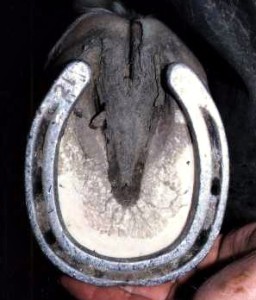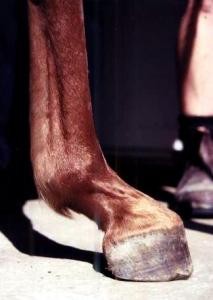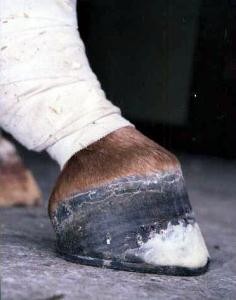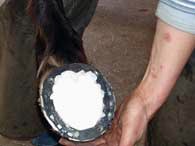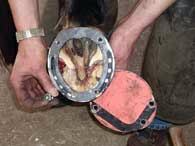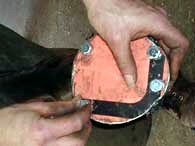Case history:
This is a machine made bar shoe that has been shaped to fit this horse’s hind foot. The sole is exposed and needs protection, and the shoe has been modified to take a hospital plate which is an aluminium plate bolted into the shoe. An old road sign was used to make the plate and the bolts and tapping tool are available from good hardware stores.
The shoe is heated and allowed to cool slowly so that it does not become too hard and is then drilled, tapped and the bolts are cut to length and fitted. The plate forms a very strong barrier between the sole and ground surface and offers maximum protection to the sole and pedal bone. The continuous surface of the shoe prevents the sole filling with dirt and bedding, and the wound can be covered with medication and dressings and changed frequently if needed.
The bolts are undone and the plate lifted during treatment. Silicone sealer around the heels and Elastoplast tape around the sole and wall can be used to form an even better seal and keep the injury clean.
This type of shoe is used for treatment of penetrating injuries of the sole, after surgery such as resection of infectious osteitis, and other traumatic injuries to the sole.
For most injuries and pain in the back half of the hoof, long, under-run heels, corns or injury to the heel or quarter, bar shoes offer protection and a greater weight-bearing platform for the horse to stand on, shifting support further back under the leg, giving an instant improvement in many cases. The shoes offer protection while an area is resected or relieved from pressure due to an injury. A partial version of a bar such as a G, mushroom or V shoe is used to greatest effect for this purpose. After bar shoes are fitted to chronically sore horses they often look relieved to finally have something under the foot for support.
The difference between an egg and straight bar is that the straight bar can move more weight-bearing support onto the frog if desired, and does not extend as far under the heels. A straight bar shoe with a small frog clip is often called an English bar shoe. All bar shoes have similar benefits and can be fitted with rolled or set under toes, fullered, plain stamped, concave, deep seated, clipped, side clipped, or graduated in thickness from toe to heel, or heel to toe, as required for the individual. Many machine made varieties are available in aluminium or steel and are easily modified.
Always address the basic principles of farriery before resorting to bar shoes. Although usually beneficial, bar shoes can also cause excessive frog or heel pressure. This is worse if the heels and frog have not been trimmed correctly and the heels are long and folded under. This will cause lameness in its own right, which can easily be confused with the need to fit bar shoes in the first place.
Many horses with bar shoes improve once they are removed and shod properly, which indicates that all the horse needed in the first place was a balanced, well fitted set of shoes. Bar shoes may force the hoof to land earlier, affecting the stride, and are often used to improve gait problems. However, bar shoes can also cause gait problems and should be used therapeutically and are not usually recommended for the front feet of horses working at speed.
Always remove bar shoes and return to standard shoes when they are no longer required. I avoid bar shoes unless they are strongly indicated for the horses problem and are showing a benefit once fitted.
Egg bar shoes
Egg bar shoes increase the weight-bearing surface and create a larger area of posterior support for the foot and leg, thus moving the center of gravity further backwards supporting under-run heels. Corns, contracted heels, navicular disease, laminitis, heel injuries, and race horses that go “down on the bumpers” may all benefit from these shoes if applied properly. Available in machine made varieties from steel through to aluminium alloys, many farriers hand make bar shoes for the individual horse.
